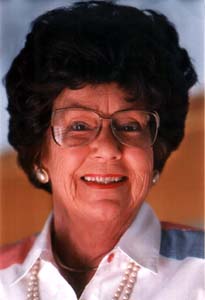 Barbara Erickson London was bornJuly 1, 1920, in Seattle, Wash. Halfway through college she enrolled in theCivilian Pilot Training program. She was a natural pilot and workedquickly through her commercial and instructor’s ratings. She stayed at theschool and trained other CPT and Naval Transport Service students. In 1942, with the war in fullswing, she joined the Women’s Auxiliary Ferrying Squadron, the first group ofwomen pilots formed during the war. Later, the Ferrying Squadron would becomepart of the larger organization called Women’s Air Force Service Pilots (WAFS).The ferry pilots were often standing at the door as the airplane rolled out, sowere they the first pilots to fly that particular airplane. Barbara (also knownas "B.J.") flew all of the single-engine fighters and most of thetwin-engine bombers of the era. She also logged some B-17 time. In one five-dayperiod, she flew four 2,000-mile trips. Barbara became the Commanding Officer ofthe WAFS, stationed at Long Beach, Calif. In 1943 she was awarded the Air Medalby General Hap Arnold. She’s the only woman pilot from WWII to receive thatmedal.
Barbara Erickson London was bornJuly 1, 1920, in Seattle, Wash. Halfway through college she enrolled in theCivilian Pilot Training program. She was a natural pilot and workedquickly through her commercial and instructor’s ratings. She stayed at theschool and trained other CPT and Naval Transport Service students. In 1942, with the war in fullswing, she joined the Women’s Auxiliary Ferrying Squadron, the first group ofwomen pilots formed during the war. Later, the Ferrying Squadron would becomepart of the larger organization called Women’s Air Force Service Pilots (WAFS).The ferry pilots were often standing at the door as the airplane rolled out, sowere they the first pilots to fly that particular airplane. Barbara (also knownas "B.J.") flew all of the single-engine fighters and most of thetwin-engine bombers of the era. She also logged some B-17 time. In one five-dayperiod, she flew four 2,000-mile trips. Barbara became the Commanding Officer ofthe WAFS, stationed at Long Beach, Calif. In 1943 she was awarded the Air Medalby General Hap Arnold. She’s the only woman pilot from WWII to receive thatmedal.
After the war she married Jack London Jr. (not the JackLondon, but a relative), also a pilot. Barbara served as executive secretary forthe Powder Puff Derby until the mid ’60s, and raced every summer except the twosummers she gave birth to her daughters. She sold airplanes with Barney Frazieruntil his death in 1983. She’s now working on a couple of screenplays aboutaviation, and shares an office with her younger daughter, a pilot andtransportation consultant. Her older daughter, Terry London Rinehart, wasthe first woman pilot hired by Western Airlines in 1975, and is now a DeltaAir Lines captain. B.J. is something of an expert on Long Beach Airport, havingworked there since the mid ’40s. She stays busy as a community advocate for theairport, which hosts the AOPA Expo later this year and NBAA in 2001.
How did you get started in aviation?
I got started the way a lot of girls got started, through CPT [Civilian PilotTraining]. In 1939 I was a sophomore at the University of Washington and I sawan ad in the paper announcing a course. After a lot of discussion they decidedto allow one woman for every ten men. So there were 40 men and four women. Itook the physical and was accepted. I got my license, went back for thesecondary program and got my instructor’s permit. Girls weren’t allowed past thefirst class. The attitude was that women pilots were never going to be usedanywhere and would be of no value in an airplane, so there was no program toprepare them for anything further. But I had some friends at the CAA [now FAA]and with a little bit of push I got into the advanced classes.
I had never flown before. I didn’t come from one of those families where wewent down to the airport on the weekend and stared over the fence at theairplanes. I know that’s how some people got into it, but that’s not the casewith me. I wasn’t anywhere near an airport. Boeing was way across town. SandPoint wasn’t too far away so occasionally we’d watch the military planes, but Iwas in no financial shape to tackle flight instruction on my own.
Sixty years ago, women didn’t have the choices they have today. In those daysif you were in college, unless you were studying to be a doctor or a lawyer or ascientist or something specific, there were only a couple of alternatives opento women. You could take Social Studies, or Home Economics, or PhysicalEducation. I decided to be a Home Economics major but once I found flying myinterest in Home Economics waned.
Did you encounter any resistance as a female flight instructor?
There weren’t a lot of us. But I had grown up with this particular flightschool. They had put me through all the courses and when I got my instructor’srating they hired me to stay on and teach all the things I had just learned. Theprogram had changed from CPT to WTS, which I think was War Training Service.Most of the students were navy cadets.
I got some resistance early on. I still correspond with the FAA man who gaveme my first license in 1940. His name is Jack Feeny, he’s 94, and we’ve beenexchanging love notes for 60 years. He helped me get the instructor’s job inWalla Walla, where the school moved when the government stopped all the flyingalong the west coast. The school had told him that the cadets didn’t want some20-year-old girl teaching them how to fly. But he asked them to give me a tryand it worked. Most of the boys I was teaching were older than me, and it workedout fine.
Then I got the call to go into the military. Luckily, the guy I was workingfor said "go." He could have held me there because I was teachingunder a government contract. But he knew it was a good opportunity for me andlet me go.
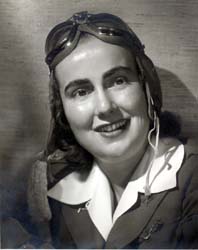 |
How did you get the call?
Nancy Love and her husband Bob worked for the ferry command. Male pilots werein short supply so Nancy had been researching the possibility of using women whowere already qualified pilots to help with the ferry command. She figured thatthere were about 100 women in the country that already had commercial and200-horsepower ratings, were current, were between the ages of 21 and 25, andhad at least 500 hours time. She did the research and there were about 100 ofus. About half of us had come through the CPT program.
Since we already knew how to fly all we would need was to learn the militaryway. We had 30 days of indoctrination and we started ferrying in September1942.
What was your first ferry flight?
It was in a Cub from Lockhaven, Pa., to New Orleans. It was the middle of thewinter. To this day I can’t tell you, with no radio, how we ever found where wewere going, because the ground was covered with snow. You could see a railroador a road once in a while, but that’s about all. Flying the open-cockpit PTs[primary trainers] with goggles, the map on our lap, freezing cold, trying tolook at the ground, which was covered with snow, I don’t know how we ever foundGreensboro, N.C. But that was our job, that’s why we were there, so we used acompass and a map and we made each delivery without a problem.
Did you fly alone or as a group?
We flew alone. There may have been several pilots all headed in the samedirection at the same time, but we didn’t fly in formation or even loosely as agroup. We were each responsible for getting our airplane where it was going.
How did the ferry pilots get back to base after your flights?
In the beginning we just hopped on the airlines, or took a train or a bus. Ifyou landed in a big city like Atlanta or New Orleans you could probably take theairline. If it was a smaller place that probably meant taking a bus to a biggercity. As the program grew it got more sophisticated and as we dropped anairplane off they would try and align us with something coming back the otherway. If we took a P-51 to Newark, we’d go to Long Island and pick up a P-47 andbring it back to Alameda. Eventually they were able to coordinate the trips, butin the beginning we just got on the airline and came home.
Were you flying airplanes that hadn’t been flown yet?
Sure. We were told that only every fifth P-51 had ever been flown before weflew them. They didn’t have time. They didn’t have pilots. We were picking themup as they rolled out the door. The airplanes were built so well that we didn’thave a lot of problems. They were putting almost two P-38s a day out the door, aB-17 a day, at least one P-51 a day. That’s why we needed the ferry command, todeal with the volume of airplanes. And 90 percent of the people who were buckingthose rivets were women who up to then had been home baking waffles for theirfamilies. And some of the men had no experience building airplanes. Somebodyhanded them a blowtorch and a rivet gun and off they went. Those airplanes werebuilt for the war but so many of them are still flying, sixty years later. Sothose are the unsung heroes of the war.
What’s the connection between the ferry pilots and the WASPs?
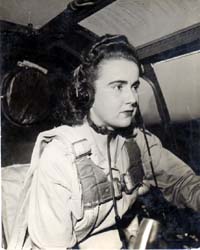 |
That’s long, complicated, and somewhat sad story. There are some books on thesubject, but if you weren’t there it’s hard to understand all the complexities.The women ferry pilots started out as a group of 25, in September of 1942. Atthat time, Jackie Cochran was in England with her group of women pilots. Infact, I was almost in that group. I had been accepted and was ready to go when Iheard about the ferry pilot opening in the U.S. so I stayed home. So when Jackieheard that Nancy had started a group at home, she came back from England andpounded on Hap Arnold’s desk and said that job had been promised to her. He hadpromised her that if a women’s program ever started it would be hers to run. Sowhat happened is Jackie started a training program, called the WTC, inSweetwater, Tex. It was exactly the same flight training program as the men had,and the goal was to train women to be able to join Nancy Love’s ferry command.
In January of ’43, our group of 25 was split into four groups. Ten stayed inWilmington, five went to Detroit, five went to Dallas, and five went to LongBeach. I was assigned as CO of the five that went to Long Beach. In April, whenJackie’s first class graduated, they were split between the four groups of theoriginal 25. I got a small group from class one, and a bigger group from classtwo, and a bigger group from class three, and I gradually built up my squadronhere in Long Beach.
But after a few classes, Jackie ran out of women who met the qualifications,so the requirements dropped from age 21 and 500 hours to 18 years old and 35hours. So by the sixth class, in the summer of ’43, the girls that weregraduating didn’t have the 400 hours necessary to be a ferry pilot. They went inwith 25 and maybe got another 250 in school. Because the graduates didn’t meetthe ferry command requirements, the ferry command stopped accepting graduatesafter about the sixth class.
So then Jackie had to find a place for the graduates. They started sendingthe girls to tow targets, which became very big. They did some engineering testwork. When a new engine was put on an airplane it had to have five hours run-intime, so they were stationed at the bases and did that. And they did somecourier work and some instruction. So as these various groups developed, theferry pilots became one of the groups in the WASPs. Technically Jackie was incharge of everybody but in reality Nancy was in charge of the ferry pilots,which peaked at just under 300 girls.
Did the ferry pilots have a distinctive uniform?
The original 25, before Jackie got the name changed, had regulation grayuniforms. Later, we dressed just like the men. So for nine months we had nouniforms, so we wore pinks and greens in the winter and khakis in the summer,just like regular army. Then in August of ’43 when Jackie got the name changedand came up with the blue uniforms, we wore those. The ferry pilots were moreinterested in the flying so nobody really cared much what we were wearing.
Our original WAFS group sort of broke up into three groups. One group was CPTgirls, who came from average working-class families and were able to fly becauseof that program. Another group had enough money to go to private flight schoolsto get their training. And the third group made a living on the airshow circuit.Theresa James was in that group. She was a wingwalker, and Evelyn Sharp hadgiven rides — she had flown over 2,000 people by the time she got to us. So ourgroup had three elements but we blended together and did our jobs. The logicalplace for us in the military was the WACs but our backgrounds were different andit was not a good match.
Why was that?
A lot of our girls were older, some were married, some had children, and theWACs were a younger group that didn’t have husbands or children. Some of ourgirls were 35 years old when they went in, so mixing with the younger girls inthe Army was a misfit. That’s part of the reason we were never militarized anddidn’t get Veteran status until over 30 years later. Also, Jackie Cochran didn’twant to be under Oveta Hobby and the WAC organization.
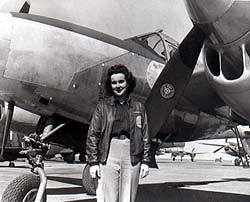 |
What’s your perspective on the end of the war and the end of the program?
In August of ’44, when the Ramspeck Committee met, there was a group of us —Nancy Love, myself and a few others — that was in Orlando at Officer’s school.They figured we were so close to being militarized that they’d get the firstgroup through the school. But it was too late to militarize us. The war waswinding down, they were closing the men’s training schools, and the men who hadbeen instructors and pilots had to be stationed somewhere. They had taken thosejobs so they wouldn’t be drafted, and it was a necessary job and they did itwell, but by the same token they couldn’t just show up the next morning andexpect to take my job. In some respects the women were more qualified than themen. We had more P-51 time than the primary instructors. So as the schoolsclosed we had thousands of men who needed a flying job which in some cases wasalready held by a more qualified woman.
Plus we had a lot of war-weary pilots coming back, who had served their tourof duty. They appealed to the veterans’ groups, like the DAR and the VFW thatthe girls who had originally been brought in to release the men for war dutywere now occupying "their" jobs. Sothat’s the case that was made to the Ramspeck Committee, and when the voteto militarize us went before Congress, it failed. A lot of it was timing. Thewar was ending. If we were going to be militarized, we should have beenmilitarized much earlier.
So they had a lot of pilots but not necessarily the right kind of pilots. Themorning I and my 40 girls left Long Beach, there were 60-some P-38s and P-51ssitting in the middle of Long Beach airport that didn’t get delivered that day.For months they had to go to fighter commands for pilots or spend time and moneytraining other pilots to do the jobs we had been doing. I was devastated when Ihad to leave Long Beach. One day you’re flying a P-51 to Newark and the next dayyou’re driving back home to Seattle wondering if you can get your old job backat Macy’s.
We all had a tough time adjusting. The men coming back had the same problem.One day they were dressed in uniform and being honored as heroes, and the nextday they’re walking down the street in jeans and nobody knows who they were.
I was 24. I applied for a job with the airlines and they sent me back anapplication to be a stewardess. Well, that wasn’t what I had in mind. There wereno opportunities for women pilots in general aviation. The plan was for GA toexplode after the war. There was going to be a Piper Cub in every garage. Didn’thappen. So finally I got offered a job at Ryan in San Diego. They had a testprogram in a new airplane. So I was on my way to Ryan and I stopped in LongBeach to visit my boyfriend and we decided to get married. So I stayed in LongBeach and never got to San Diego.
Was your husband Jack London related to Jack the writer?
Shirttail relative. Jack London was a penname. He was a boy from an unmarriedrelationship in Oklahoma that was adopted by my husband’s family. So he took thename Jack London as his penname. So we’re not blood relatives, but I do knowwhich branch of the family tree adopted him. There are a million Londons inOklahoma and Texas.
I’ll tell you something interesting. My dad was in the book business. Heworked for McMillan. I never had to go to a library because our house was loadedwith books. My mother always wanted to name her first daughter Charmian.Charmian was Jack London’s wife’s name. My maiden name is Erickson and my dadwasn’t crazy about the name Charmian but my mother said if she had known I wasgoing to marry a Jack London I would have been Charmian no matter what my dadsaid. Barbara was a very popular name in my era. Of the original 25 ferrypilots, four of us were Barbaras. That’s how I got the nickname B. J.
Who were some of the folks you flew with?
One of my best friends was Douglas "Wrong Way" Corrigan., who was aferry pilot with us at Long Beach. His flight to Ireland started in Long Beach.Before he died, he would come to the Long Beach airport open houses and sit at atable and tell his stories. He was a character. He didn’t like hotels andrestaurants, so during the war he slept in his airplane and ate candy bars. Hedidn’t like the military life, so he quit and went to work for Douglas as a testpilot. He didn’t have half the airplane that Lindbergh had. You wouldn’t thinkit would go across town, much less across the ocean. So the fact that he made itto Ireland with such a small, ill-equipped airplane was a real feat.
One of my ferry pilots was a Busby Berkley dancer. Her name is Loretta Foy.She became a famous helicopter pilot. Some were schoolteachers, clerks, buyers,housewives, they just came from everywhere.
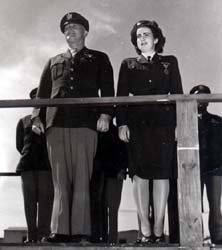 Barbara receives the Air Medal from General Hap Arnold, 1943 |
What did you do after the war ended?
I was executive secretary for the Powder Puff Derby for 20 years. That was agreat training ground for teaching how to fly cross- country. I raced every yearexcept the two summers I had my girls. Then I went to work for Piper in the ’60suntil the company was sold. Then Barney Frazier, my sales manager, and I wentinto business for ourselves in 1970. He died in ’83 and my younger daughter cameto work for me for a while. Then she went on to start her own business. My otherdaughter went on to the airlines and is a Captain for Delta. Since I retired,I’ve become a consultant. I help anybody that’s trying to buy or sell anairplane.
Do both of your daughters fly?
Yes. My younger daughter shares the office with me. She now does PR work forthe transportation industry, did work for WinAir when they were based here, juststarted work for a company called Ejet, anddoes some work in local politics. She is a commercial, multiengine instrumentpilot with about 1,000 hours. My older daughter Terry has been with the airlinesfor 25 years. She is now stationed in Salt Lake City flying 737s.
When did you first see aviation catch on with Terry?
She always wanted to be an airline pilot. But you have to understand my kidswere raised in an airplane. When we went to grandma’s we went in an airplane,not in a car. So both of them were exposed to aviation early on. Terry knew thatit would be tough, but she wanted to be an airline pilot. It took her 10 years.The younger one didn’t have that same drive to fly … her passion was horses.She spent her teen years doing jumping contests. Then she gave up all theceremony and went back to spurs and chaps and wound up as a state cuttingchampion. But she learned how to fly when she came to work for me after Barneydied. Once she started she was a real natural pilot.
I always told them that there was no reason girls couldn’t fly. The airplanedoesn’t know the difference. It’s just a matter of learning. And the reward isyou get to see the world from an airplane, and meet the greatest group of peopleon earth.



































